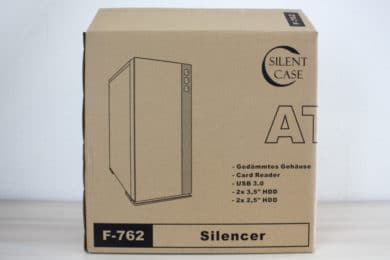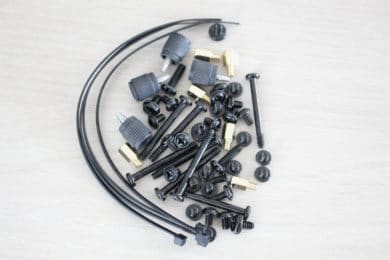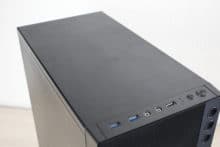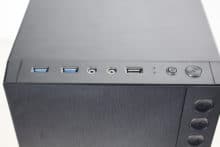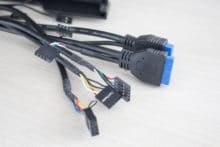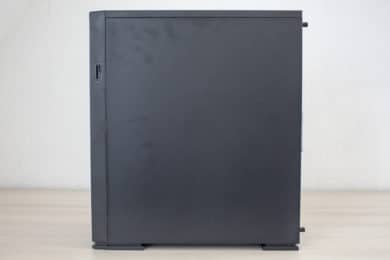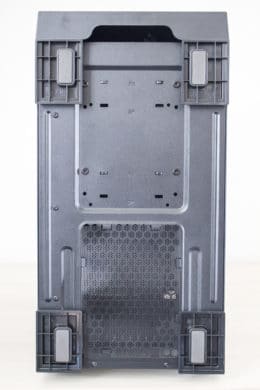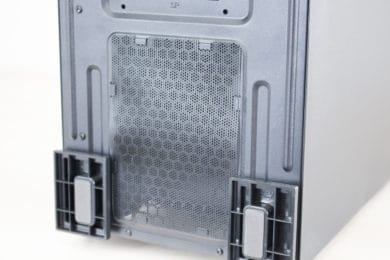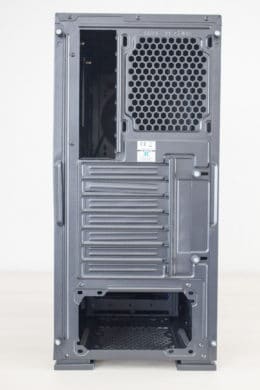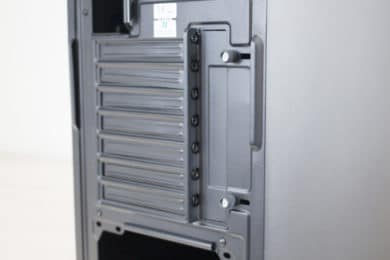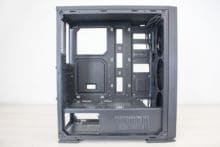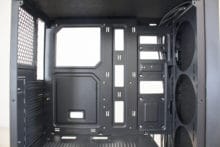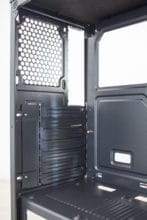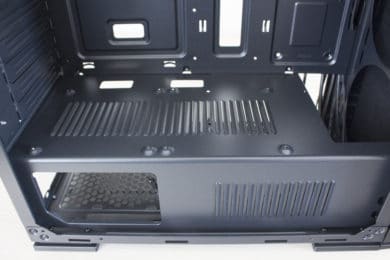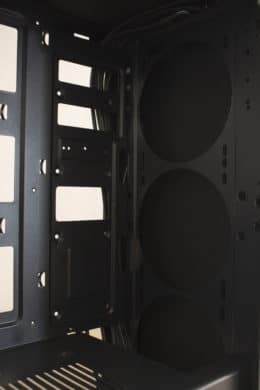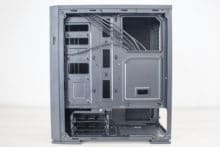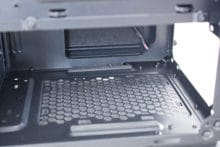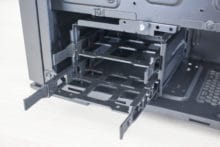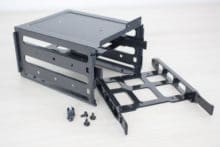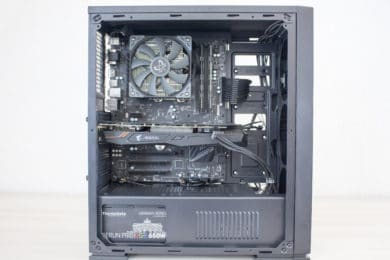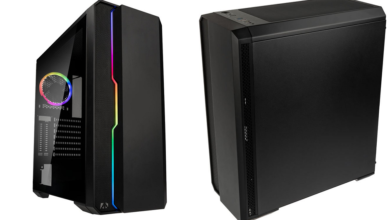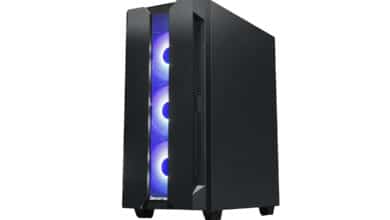
In mid-September, Inter-Tech, the German manufacturer of PC components, expanded its product range with a new housing without much notice. The new Midi-Tower has been given the name F-762 Silencer and, as you can perhaps deduce from the name, represents a simple case with a focus on noise reduction. Additional features include compatibility with AiO 240mm water-cooled radiators, a generously sized interior and an integrated SDHC card reader. The F-762 Silencer is only available in a black version and costs Price not available *.
Whether this price is justified for the Inter-Tech F-762 Silencer and how it performs in general, we will find out in this review for you.
Technical Details
| Model: | Inter-Tech F-762 Silencer |
| Housing type: | Midi Tower |
| Dimensions: | 205 x 440 x 400 mm (W x H x D) |
| Weight: | approx. 5 kg |
| Material: | Steel, plastic |
| Color: | Black |
| Front connections | 2x USB 3.0 Type-A, 1x USB 2.0 Type-A, 1x speaker, 1x microphone, 1x SDHC card reader |
| Drive bays: | 2x 3,5″/ 2,5″ (HDD cage, internal) 2x 2,5″ (motherboard tray, internal) |
| Extension slots: | 7 |
| Form factors: | ATX, mATX, mini-ITX |
| Ventilation: | Front: 3x 120 mm Rear: 1x 120 mm Power supply cover: 2x 120 mm |
| Radiators: | Front: 1x 240 mm or 1x 120 mm Rear: 1x 120 mm |
| Max. CPU cooler height: | 155 mm |
| Max. Graphics card length: | 325 mm |
| Max. Power supply length: | 160 mm (with HDD cage) |
| Cable management space: | 20 mm |
| Place for front radiator: | unlimited (restricts GPU length) |
| Price: | Price not available * |
| Special features: | Dust filter, cable management, sound attenuation, SDHC card reader |
Scope of Delivery
The Inter-Tech F-762 Silencer comes well and safely packed in a brown cardboard box with black lettering and is wrapped in normal polystyrene and a plastic film. The included accessories are stored in a plastic bag in the hard disk cage below the power supply cover. The accessories include all important screws and cable ties. Installation instructions are unfortunately not included with the case and cannot be downloaded from the homepage. In addition, the manufacturer has pre-installed some spacers for the mainboard. What is not included in the scope of delivery are case fans.
Exterior Impression
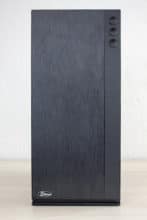
Externally, Inter-Tech has designed the F-762 Silencer to be very simple and unobtrusive. It looks like a silent housing of the first hour. But let’s start in the front. It consists of a plastic element, which was provided with a structure of brushed aluminum. As an optical highlight, Inter-Tech has added a carbon strip and three buttons to the right side of the front element. However, these have no effect and are only optics. If you look at the side parts of the front, you can also see an SDHC card reader. What we miss however are openings or fan grilles through which the front fans can transport fresh air into the interior. Only a small recessed grip on the underside could allow air to flow in. Unfortunately there is also no dust filter in the front. For better noise insulation, the front element was lined from the inside with an insulating mat.
Next, let’s turn to the lid section. This follows the simple design concept optically and is completely closed and insulated from the inside. The F-762 does not have a possibility to open certain areas for a better airflow. The I/O panel is located in the front area and attached to the front element. There are three USB ports (2x USB 3.0, 1x USB 2.0), 1x headphone and 1x microphone, as well as two buttons for power and reset. However, these connectors are very strangely divided. Each USB 3.0 port has to be connected to the mainboard individually via an 18pin header. If the motherboard does not have two internal 18pin headers, both USB 3.0 ports of the I/O panel cannot be used. On request, the manufacturer has assured us that this connector design will be changed in the future.
Both side parts are completely closed and lined with insulating mats from the inside. These make both side panels look stable and have a good weight. For easy disassembly, both side panels have practical removal aids and knurled screws.
The underside of the F-762 Silencer doesn’t hide any special highlights. The Midi-Tower stands on solid plastic feet which have been fitted with rubber strips to reduce noise. The power supply at the bottom is protected from dust by a mesh filter.
The back side corresponds to the usual standard of current midi towers. The power supply is mounted at the bottom, above it there are seven slots for PCI expansion cards. These are screwed from the outside and are reusable. A 120 mm fan can be attached to the rear of the case to transport the warm exhaust air out of the case. However, you have to buy this one as the manufacturer doesn’t have pre-installed fans.
The external processing and the varnishing are basically in order. However, the majority of the total weight is carried by the side panels. If you take these off, the body is quite light and only conditionally torsionally stiff. A higher material thickness would have been desirable, but would probably have resulted in a higher price.
Inside Impression
Inter-Tech has also been following the current trend for some time now, designing the interior very openly and dividing it into two chambers with a power supply cover. The area above the power supply tunnel is very open and has various openings for better cable routing. To the right of the mainboard tray there are openings and two mounting points for SSDs or 2.5″ hard drives and space for three 120 mm fans.
The power supply tunnel covers almost the entire lower part of the Midi Tower. However, to ensure compatibility with AiO water cooling systems, the cover has a cut-out in the front area. Two additional 120 mm fans can also be mounted above the cover. The airflow for these fans is to be ensured by openings in gill optics.
Let us now turn to the back and the lower chamber. In this chamber the power supply and two more hard disks will be placed. The manufacturer has installed a hard disk cage to the left of the power supply area. In this cage either two 3,5″-HDDs can be fixed without tools or two 2,5″-SSDs with four screws. If the space below the cover is needed for a larger power supply, the cage can also be completely removed. The power supply unit is located to the right of the HDD cage and is mounted on steel elements, which are covered with foam rubber strips for decoupling.
The internal processing and painting are in order. The material could have been a bit thicker in some places but also in the interior.
System Construction in the Inter-Tech F-762 Silencer
Now we come to system installation. As hardware we use a AMD Ryzen 5 1400 on a MSI B350 PC Mate with 16GB Crucial Ballistix Sport LT grey DDR4-2666. The Scythe Shuriken 3* takes over the cooling of the processor. For the image output a GTX 1060 6GB by Gigabte AORUS is responsible. The power supply does the non-modular Berlin Pro RGB 650W with RGB fan. In order to enhance the cabling optically a little bit, single sleeved cable extensions from Phanteks.
The installation and the wiring of the test system were done quite fast and also possible with big hands. Only three spacers are installed ex works. Since you have to install most of it yourself anyway, this step could have been omitted during production. Since the threads in the tray are painted, screwing in is only possible with pliers or a special screwdriver attachment.
When selecting components, the buyer has to accept slight limitations, at least with a CPU cooler. The F-762 has a maximum space of 155 mm for this. With the graphics card, on the other hand, with a maximum possible length of 325 mm, there should be no problems with the currently available pixel accelerators. In addition, one could also place a 240 mm radiator in the front if required. This, however, limits the length of the graphics card accordingly.
On the back side there is about 20 mm space available to store numerous cables. In combination with the power supply cover, a neat overall result can be achieved. Even the additional cable extensions can be easily stowed under the cover and do not prevent the side panel from being reattached at the end. However, it becomes a bit more difficult when the SSD slots on the mainboard tray are both occupied. This partially blocks the cable bushings.
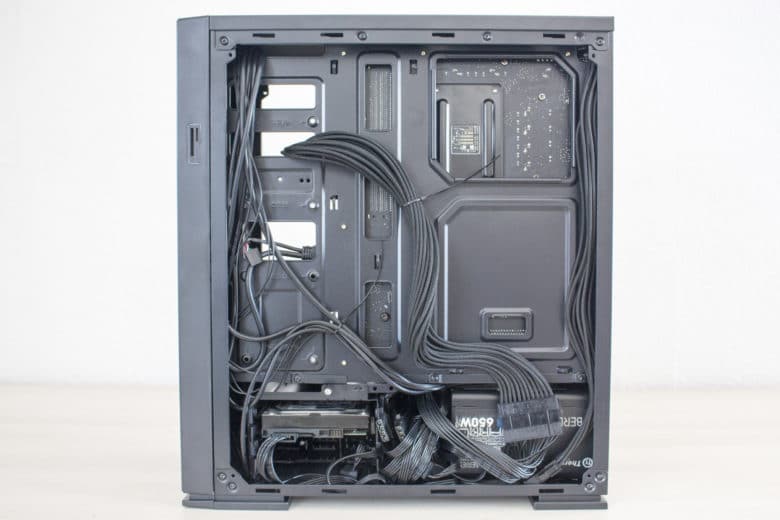
In the case of 3.5″ devices, mounting data carriers does not require any tools and is extremely simple. All you have to do is clamp the hard disks into the plastic frame provided and slide them back into the cage. SSDs in 2.5″ format, on the other hand, require four conventional screws for mounting. The data carriers are not decoupled via the frames or the cage. If the cage is not needed or if space is to be created in the front for a radiator, this can be loosened and moved or completely removed using a knurled screw. However, the maximum possible length of the power supply unit is reduced by moving it.

Finally we come to the temperatures reached in the F-762 Silencer. During the load test, Prime95 and FurMark were carried out for 15 minutes at a room temperature of 19 °C. The test was performed at a temperature of 19 °C. Since the case comes ex works without any case fan, the test was carried out in three different scenarios. Completely without fan, with two case fans and with two case fans and without front element.
Scenario |
Temperature |
| CPU: 50% (900 rpm) GPU: 50% Housing: no fan |
CPU: 80 °C GPU: 85 °C |
| CPU: 50% (900 rpm) GPU: 50% Housing: 2x Arctic P12 PWM, 50% (1000 rpm) |
CPU: 69 °C GPU: 70 °C |
| CPU: 50% (900 rpm) GPU: 50% Package: 2x Arctic P12 PWM, 50% (1000 rpm) without front element |
CPU: 55 °C GPU: 60 °C |
As you can see, both the processor and the graphics card reach relatively high temperatures in the standard configuration. However, if you install two fans, the temperature drops significantly. If you now remove the front element, even better values are achieved. From this we conclude that when buying the F-762 Silencer one should definitely add at least two case fans to the shopping cart. In addition, it is definitely noticeable that there are no ventilation slots in the front. For high-end hardware or systems that need to be overclocked, this case is not recommended.
Conclusion of the Inter-Tech F-762 Silencer Review
Now we come to the connection of this review. The F-762 Silencer from Inter-Tech is a typical silent case. No glass and no RGB, but two insulated side panels, a closed and insulated lid and a closed front. In addition, there is a lot of space in the interior and compatibility for long graphics cards and an AiO water cooling system.
But the silent features also have a negative effect. Due to the absence of any pre-installed fans and the virtually non-existent ventilation slots in the front, it gets very hot inside, and depending on the hardware. Thus, the F-762 is definitely unsuitable as a housing for high-end hardware. In addition to this large deficit, there is also the sometimes quite low material thickness and the questionable design of the I/O panel connectors (which is currently being reworked by the manufacturer).
At least on paper the Inter-Tech F-762 Silencer has promised a lot. A standard case but only lined with damping mats is only half the battle. Due to the missing airflow the F-762 disqualifies itself for many systems. Additional fan openings in the front would have been a MUST and definitely feasible. For an office system the Inter-Tech F-762 Silencer would be conceivable, but for a gaming system you should use a different case.
Inter-Tech F-762 Silencer
Workmanship
Structure
Features
Damping
Cooling
Value for Money
Low cost midi tower with insulation and plenty of space, but significant weaknesses in airflow.
